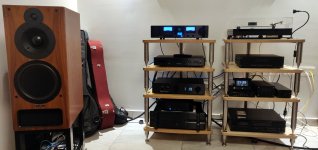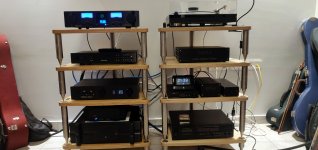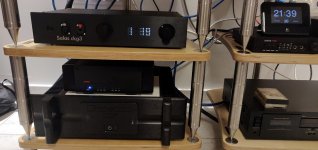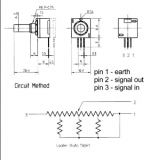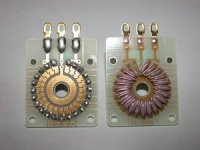Good evening Salas,
I wanted to give my pre a better potentiometer than the Alps Blue and I would have chosen what you have recommended several times and that is the one produced by TKD.
To choose the correct value, I would like to understand how the response of the pre varies between the 20k and 50k values, surely you have spoken about it in this trad, but I cannot find it, if you or someone can give me some tips, I would thank him very much.
With 20K its response is 1.15 MHz -3dB at unity gain volume position when with 50K its 700KHz.
(Those numbers I saw with switched pots of classic series type).
With 20K its response is 1.15 MHz -3dB at unity gain volume position when with 50K its 700KHz.
(Those numbers I saw with switched pots of classic series type).
good evening Salas, thank you for your reply, I will go to the 20k one even if it seems very difficult to find. If I am in trouble, I will take the 10k one by changing the resistance R1 to 5.6k.
As soon as I have made the change, I will come back to tell you the differences.
Yesterday i swapped my main amp (bryston 4b cubed)with my other one, Benchmark ahb2.before building dcg3,while listening to Benchmark dac3 as a preamp,i found bryston a little bit better than ahb2.more musical.ahb2 sounded a little darker.now, with dcg3 driving Benchmark,sound is more transparent,more musical,and definitely doesn't sound dark.dcg3 is a top sounding preamp.bravo salas!
Tested mine yesterday with Beyer DT150 and Sony Cd900ST cans.
Very happy I've built this preamp. Thank you, Salas!
It sounds very revealing, full bodied and most of all enjoyable.
Made me glued to a chair for more than an hour of listening,
despite a very modest setup:
Macbook > DCG3 20K SMD DACT type pot > Cans
Looking forward to test on new speakers soonish.
In the meantime, the attenuator I found in my bin turned out faulty.
Older open type, works only in some positions on one channel.
In need of replacement.
Here's what I've scraped for my options:
1. Back to DACT type SMD 20K – € 17 cheapest, best bang for the buck.
Can turn a little a bit bright (w/ sibilant sting) when with my TSSA amp and rising response full rangers later.
2. Blue alps – not recommended, many fakes, this preamp deserves better.
3. TKD 2cp601 series carbon 20K]400 Bad Request – € 46. Not sure it would be an improval over the #1 option for the price.
4. Dale 24 steps ladder – looks like an interesting option, any experiences?
5. TKD 2CP-2511 - € 87. I was very into trying this one, for the tone and smoothness, but then I've learned it's a shunt type (?!).
As per this thread, no significant technical advantage and non constant output impedance. Although here, no mention of shunt type.
6. TKD 2P-2511S – 21 steps 10K + 2.2K resistor– € 120. What kind of stepped resistance it uses? Still carbon, I guess. Any experiences and is it worth the investment?
7. Acoustic dimension 41-step series attenuator 10K + 2.2K resistor – € 140. Expensive territory. Hard to tell what's better in this price range.
8. Khozmo ladder 48 steps SMD 10K + 2.2K resistance – € 199.
9. Goldpoint SMD 24 steps 25K – € 152.
10. Khozmo series 25K – € 156.
11. DACT 24 steps 20K – € 170
12. Goldpoint 47 steps thin film 25K – € 227.
13. Khozmo ladder 48 steps SMD 10K + 2.2K resistance – 240 eur.
14. Haven't researched into Muses. Doesn't look like a very popular implementation. Why?
Very happy I've built this preamp. Thank you, Salas!
It sounds very revealing, full bodied and most of all enjoyable.
Made me glued to a chair for more than an hour of listening,
despite a very modest setup:
Macbook > DCG3 20K SMD DACT type pot > Cans
Looking forward to test on new speakers soonish.
In the meantime, the attenuator I found in my bin turned out faulty.
Older open type, works only in some positions on one channel.
In need of replacement.
Here's what I've scraped for my options:
1. Back to DACT type SMD 20K – € 17 cheapest, best bang for the buck.
Can turn a little a bit bright (w/ sibilant sting) when with my TSSA amp and rising response full rangers later.
2. Blue alps – not recommended, many fakes, this preamp deserves better.
3. TKD 2cp601 series carbon 20K]400 Bad Request – € 46. Not sure it would be an improval over the #1 option for the price.
4. Dale 24 steps ladder – looks like an interesting option, any experiences?
5. TKD 2CP-2511 - € 87. I was very into trying this one, for the tone and smoothness, but then I've learned it's a shunt type (?!).
As per this thread, no significant technical advantage and non constant output impedance. Although here, no mention of shunt type.
6. TKD 2P-2511S – 21 steps 10K + 2.2K resistor– € 120. What kind of stepped resistance it uses? Still carbon, I guess. Any experiences and is it worth the investment?
7. Acoustic dimension 41-step series attenuator 10K + 2.2K resistor – € 140. Expensive territory. Hard to tell what's better in this price range.
8. Khozmo ladder 48 steps SMD 10K + 2.2K resistance – € 199.
9. Goldpoint SMD 24 steps 25K – € 152.
10. Khozmo series 25K – € 156.
11. DACT 24 steps 20K – € 170
12. Goldpoint 47 steps thin film 25K – € 227.
13. Khozmo ladder 48 steps SMD 10K + 2.2K resistance – 240 eur.
14. Haven't researched into Muses. Doesn't look like a very popular implementation. Why?
Options 3 & 7 look like the more value for money choices between lower price and higher price points listed. Because 1 has practically few points of control when 3 is better built continuous and surely not bright so there are benefits, while 7 has enough steps of control and good mechanics but cheaper than its equivalents. BTW when with 10k series log option only, a +2.5k output resistor if available is bang on target extra Zo than +2.2k. +2.7k is acceptable too. Must be thin film low ppm in any case. A real ladder has double the Zo of a series pot. Does not need an extra output resistor in our case when 10k log.
Both 601 & 2511 TKD models are like half ladder. There is no central leg going up and down between two defined resistor arrays. There is one array of taps along resistive film while the wiper slides on the continuous part. When I measured the 20k log 2511 was roughly equivalent to a 20k series for Zo. Not the same behavior but thereabout. The TKD "S" ones are stated series step and I am not sure if they have discrete resistors or just using a wiper with shaft clicks.
In any case the 2CP-2511 sounds good, don't know how much better than the mini sized 601, although the Goldpoint sounds even better in my experience. But not only nominally expensive in its class, has substantial international shipping charges as well.
Both 601 & 2511 TKD models are like half ladder. There is no central leg going up and down between two defined resistor arrays. There is one array of taps along resistive film while the wiper slides on the continuous part. When I measured the 20k log 2511 was roughly equivalent to a 20k series for Zo. Not the same behavior but thereabout. The TKD "S" ones are stated series step and I am not sure if they have discrete resistors or just using a wiper with shaft clicks.
In any case the 2CP-2511 sounds good, don't know how much better than the mini sized 601, although the Goldpoint sounds even better in my experience. But not only nominally expensive in its class, has substantial international shipping charges as well.
Attachments
Siberia, I think that most of the TKD pots are conductive plastic rather than carbon.
Thanks, you're right. My bad.
Options 3 & 7 look like the more value for money choices between lower price and higher price points listed. Because 1 has practically few points of control when 3 is better built continuous and surely not bright so there are benefits, while 7 has enough steps of control and good mechanics but cheaper than its equivalents. BTW when with 10k series log option only, a +2.5k output resistor if available is bang on target extra Zo than +2.2k. +2.7k is acceptable too. Must be thin film low ppm in any case. A real ladder has double the Zo of a series pot. Does not need an extra output resistor in our case when 10k log.
Both 601 & 2511 TKD models are like half ladder. There is no central leg going up and down between two defined resistor arrays. There is one array of taps along resistive film while the wiper slides on the continuous part. When I measured the 20k log 2511 was roughly equivalent to a 20k series for Zo. Not the same behavior but thereabout. The TKD "S" ones are stated series step and I am not sure if they have discrete resistors or just using a wiper with shaft clicks.
In any case the 2CP-2511 sounds good, don't know how much better than the mini sized 601, although the Goldpoint sounds even better in my experience. But not only nominally expensive in its class, has substantial international shipping charges as well.
Thank you, Salas, for the informative feedback.
$ to € exchange rate these days is another unfavourable metric for buying Goldpoint from US.
I'm leaning towards #5 and #7.
#5 because good Zo confirmed. Guts look good (pic attached). Good sound reports confirmed. And my mind is very biased for the japanese quality at the moment.
#7 If 10K ladder is the equivalent to 20K series then it ticks all the technical parameters boxes. Attractive price in this range.
Attachments
The one in the pic should be #6 series stepped TKD 2P-2511S. Looks like having true resistors inside. Just 21 steps. Not that good stepping when with sensitive speakers. I know from experience the #5 2CP-2511 quasi ladder one with resistive film sounds clean and warm, about the 2511S I don't know. Never used it.
#7 41 step isn't ladder type, its series type.
#7 41 step isn't ladder type, its series type.
If your speakers will be potentially bright #5 is safer. Its also available as 20k Log from HiFi Collective. If your speakers will be surely neutral #7 may give you bit better detail without etched tone danger. Also the difference in bulk between pots can be a practical build factor.
Speakers will be potentially bright on axis (until maybe flattened).
So taking the safe side.
Thank you for the motorized ver heads up.
I'll stay with an analogue version and on the safe side again,
because with a motor, knowing myself, I'd risk delaying my finished build.
So taking the safe side.
Thank you for the motorized ver heads up.
I'll stay with an analogue version and on the safe side again,
because with a motor, knowing myself, I'd risk delaying my finished build.
Hi,
A bit off topic noob question because it's more about the i-select thing:
according to the pics, some people connect the inputs with separate single wires, others with shielded (single/double) ones... What is the recommendation for the connection between the input connectors to the i-select board? 3 single wires sounds easier though.
The i-select board is about R-Ground-L, while the DCG3 board is for R-Ground, L-Ground. Kind of disturbing for noobs
A bit off topic noob question because it's more about the i-select thing:
according to the pics, some people connect the inputs with separate single wires, others with shielded (single/double) ones... What is the recommendation for the connection between the input connectors to the i-select board? 3 single wires sounds easier though.
The i-select board is about R-Ground-L, while the DCG3 board is for R-Ground, L-Ground. Kind of disturbing for noobs
Prefer coax in general. In really short distance, separate wires would not bother much though if away from transformers, because line level is strong signal. If you will go with separate wires keep them bunched together per input. In case of an error you will know it, there will be buzz.
If you look at the copper foil on the top of the board you will see all the G leads are tied together in what looks like ground buss.I dont see why you cant use 3 leads. I plan on using 4 leads as I prefer using shielded wire.
In V1.03 boards the L side ground buss is separate to the R side ground buss. There are also blind bridging pads between buss sides located at middle distance underneath to be linked together if ever needed. They are L shaped gold areas facing away from each other.
- Home
- Source & Line
- Analog Line Level
- Salas DCG3 preamp (line & headphone)
